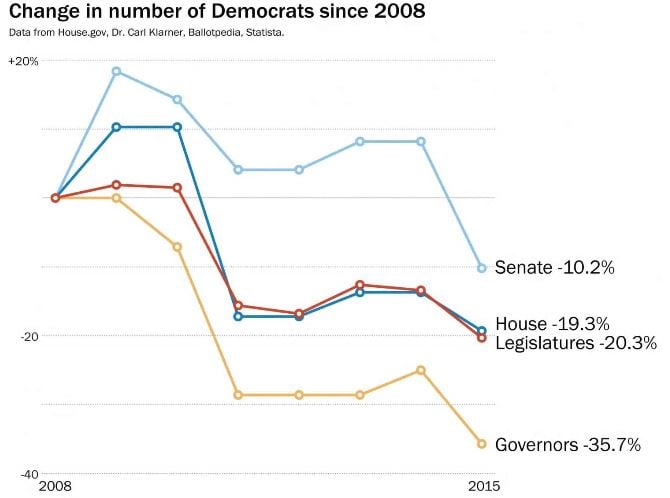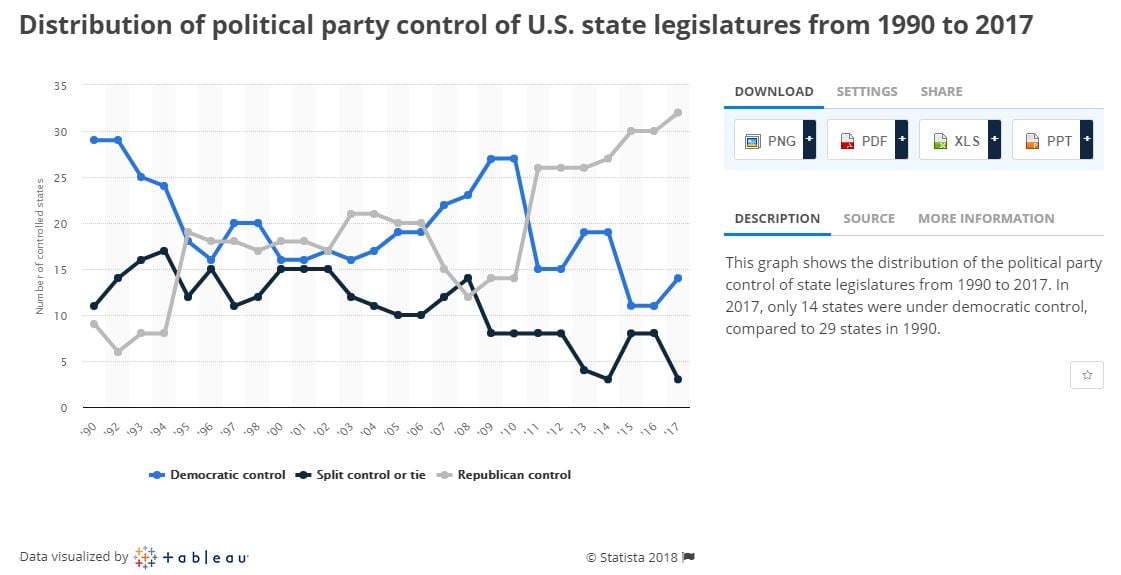The four states that held primaries last night for the coming 2018 elections — Ohio, Indiana, North Carolina and West Virginia — are overwhelmingly controlled by the GOP. Republicans control all eight state legislative bodies within them, with 396 Republican state legislators compared with 189 Democrats. Three of the four states are Republican trifectas, meaning the GOP controls their governorships in addition to all of their legislative bodies.
If Democrats hope to claim and sustain majority status in Congress anytime soon, they will need to reverse this GOP domination of state governments in 2018. State legislators who are elected in 2018 will be among those tasked with rewriting the maps for the 2020 redistricting. As a result, a vote in 2018 can have an impact for a decade. The importance of this was explained by infamous Bush operative Karl Rove who in 2010 said, “He who controls redistricting, can control Congress.”
Republicans clearly understood the importance of redistricting 10 years ago and strategized accordingly. Now, the GOP controls almost every body of government in the US: The House, Senate, White House, 33 governorships and 69 of 99 state legislative bodies.
The GOP’s electoral successes occur, however, even though the country is moving left on economic issues and social issues. Support for gay marriage, legal marijuana, guaranteed health care and citizenship for undocumented immigrants is at an all-time high. Support for military interventionism is down. On the whole, young voters are well to the left of their older generations, and only 42 percent say they prefer capitalism to socialism.
The fact that the US government is leaning right, even as the populace is leaning left is a problem in a representative democracy. This disjunction was particularly apparent when Senate Republicans addressed health care policy, the top concern for Americans, according to numerous polls. The Better Care Reconciliation Act — the GOP’s top legislative priority — was supported by only 12 percent of Americans at one point. There is just not much appetite for GOP policies. This is one reason Donald Trump was able to win the primary against contemporary Republicans by (publicly anyway) breaking with the party on trade.
So, how is it, absent a flood of support for GOP policies, that the Republicans have been winning elections at every level for a decade? And what does it say about the pervasive effect gerrymandering has on our democracy?
REDMAP in 2010: How the GOP Keeps Winning
David Daley, who has covered this issue for Salon, traces the answer to this first question back to June 2009 at the Hermitage, a pricey Nashville hotel. It was here, Daley said in an interview with Truthout, where the Republican State Leadership Committee (RSLC) first presented the Redistricting Majority Project. It became known better as REDMAP, which Daley calls an “audacious strategy that would soon transform American politics.”
REDMAP was a shrewd twist on gerrymandering, the undemocratic practice of drawing maps to maximize partisan gain. The focus was deliberate: target key state legislative seats, since these legislators would be redrawing the maps after the 2010 census.
“At the time many of these seats were not competitive races,” said Harvard professor Gary King, an expert on legislative redistricting, in an interview with Truthout. “They knew if they could control a legislature, they could move a district. It was a massive advantage.”
By 2010, Daley reports, the RSLC decided to invest $30 million in 107 carefully chosen state legislative races, most of which was used for ad blitzes late in the campaign. By the time the election was over 650 state legislative seats changed party hands. Tim Barnes, former president of finance for RSLC, boasted after the election in a thank you note to donors that of 70 competitive districts, “Republicans now control the redrawing of at least 47 of those districts … Democrats are responsible for 15 districts and a non-partisan process determines the additional eight.”


It must be noted that the Democratic Party also engages in gerrymandering and can be as aggressive as Republicans. Former Governor Martin O’Malley helped take a Republican seat in Maryland using gerrymandering during the 2010 redistricting. This approach led to litigation that is now before the Supreme Court (Benisek v. Lamone). “Part of my intent was to create … a district where the people would be more likely to elect more Democrats than a Republican,” O’Malley conceded in a deposition.
But despite a clear willingness to use gerrymandering for their own gain, Democrats were not up to the task in 2010. “They simply lacked the foresight of the GOP and were focused on top-of-the-ticket races,” King said. “Not coming up with a viable counterstrategy once it was apparent what the GOP was doing, was really ineptitude.”
King notes that Rove outlined this plan in the Wall Street Journal. “It wasn’t like the Republicans were being secretive about it the whole time,” he said. Still, the Democrats were unable to respond effectively.
Meanwhile, the Republicans made use of data and technology that did not exist in prior rounds of redistricting, improving their ability to microtarget the rights seats. “Partisan gerrymandering is as old as American politics, of course,” said Daley, who also authored a 2016 book on the subject. “But from 1790 to 2010 it was a different era. New technology has since turned it into an art,” ushering in “the steroid era of gerrymandering.”
Indeed, researchers in 2016 found that “partisan bias in congressional district maps [in 2010] tripled compared to the post-2000 districts.”
Stacking the Deck
To study the success of REDMAP is also to witness the harmful effects of gerrymandering. For the last decade, the maps written by mostly Republicans have given the GOP a lot more seats than Democrats, without getting a lot more votes. King uses the 2012 and 2014 Wisconsin elections to demonstrate the impact.
Here Republicans received 48 percent of Assembly votes statewide in 2012. The districts were drawn in such a way, however, that they won 60 percent of Assembly seats. In 2014, under the same redistricting plan, King notes in a Boston Globe op-ed, “Democrats received 48 percent of the vote, but just 36 percent of the seats.” This means the map lacks “partisan symmetry,” the subject of an important coming Supreme Court case Gill v. Whitford. (This is one of two important gerrymandering cases coming before the court, along with Benisek v. Lamone but neither are likely to impact the 2020 redistricting process, no matter the ruling).
One can see the disenfranchising impact of gerrymandering here. Wisconsin’s voters got Republican majorities even when they voted for Democrats. In a sense the legislators — not the citizens — are choosing which votes count and where.
Daley also cites instances of extreme gerrymandering and its fallout. He writes:
Republicans held the U.S. House in 2012, despite earning 1.4 million fewer votes than Democratic congressional candidates, and won large GOP majorities in the Ohio, Wisconsin, Michigan and North Carolina state legislatures even when more voters backed Democrats…. Even in Virginia last November [2016], Democrats won nearly a quarter of a million more votes than Republicans — and it still wasn’t enough to overcome district lines rigged to guarantee the GOP a built-in advantage. In Alabama, where Doug Jones recently became the first Democrat elected to the U.S. Senate in decades, disgraced GOP candidate Roy Moore still carried six of the state’s seven gerrymandered congressional districts.
Another consequence of gerrymandering is its detrimental effects on third parties. Both the Libertarian Party and the Green Party have criticized the process.
“Third parties [suffer] greatly as a result of partisan gerrymanders. In 2014, 58 percent of Americans agreed that a third party is needed in the United States; gerrymandering, however, makes it nearly impossible for third party candidates to come to power,” writes Lexi Mealey in the Harvard Political Review. “In districts designed to ensure the success of one of two major parties, candidates that do not conform to either ideology are left with an extremely limited, if existent, voter base.”
Redistricting Battle Starts With Coming Elections
Democrats have been reeling ever since REDMAP, without a viable counterstrategy. Now the Democratic Legislative Campaign Committee (DLCC) and progressive grassroots organizations are apparently heeding the lessons from the last census in an attempt to prevent another decade of GOP control. They are letting everyone know that the 2018 election will have an impact on the makeup of Congress for a full decade, as did the 2010 debacle. Winning the states, the DLCC notes on its website, is “the only sure way to prevent GOP gerrymandering from ever again deciding the outcome of a national election.”
CNN reported it was the “36th GOP-held state legislative seat to change parties since Trump took office” and is being cited by Democrats as “evidence it can win in Republican strongholds.”This emphasis is apparent from the DLCCs response to a key state legislative victory for Democrats in Florida. “We look forward to gaining more ground in 2018 and 2020 elections ahead of critical redistricting,” said Jessica Post, executive director of DLCC, in a statement after the election. “Tonight’s win comes on the heels of the DLCC announcing a new record for first quarter fundraising of more than $5 million.”
“Special elections have been favoring Democrats,” said Tyler King, a staff writer at Ballotopedia, in an interview with Truthout. “In 2017, Democrats flipped 14 seats compared to three flipped by Republicans. In 2018, all six flipped seats have gone to Democrats. Special elections aren’t always the best bellwether because they often have special circumstances attached to them, but it is notable … Democrats are in a better position to win seats in state legislatures in 2018 than they have been since 2010.”
Obama v. GOP Maps
In his last State of the Union in 2016, Barack Obama said “We have to end the practice of drawing our congressional districts so that politicians can pick their voters and not the other way around.” One can understand why he emphasized this on his way out of the White House. When Obama was elected in 2008, Democrats had dominated their second straight election and took a supermajority in Congress.
“When Democrats won in 2008, they thought they would be able to hold on to these majorities with the Obama coalition. They did not see this coming,” Daley said.
When the GOP rebounded in 2010 and redrew the maps, Obama never had a Democratic House again. His party lost the Senate and as many as 1,000 state legislative seats during his presidency.
Obama’s window to pass meaningful reforms was much smaller than he likely anticipated — the Affordable Care Act, Dodd-Frank and the stimulus bill were all passed in his first two years in office. The GOP Congress, solidified by groundwork laid out in REDMAP, effectively ruined any chance Obama had of passing significant legislation for the rest of his presidency. They also deprived him of a Supreme Court Justice. It is therefore understandable why the former president attended a fundraiser by the National Democratic Redistricting Committee (NDRC), led by his former Attorney General Eric Holder, to raise awareness on GOP redistricting success and its consequences.
“Since 2011, Republicans gerrymandered the country more aggressively than at any time in our history,” the NDRC says on its website. “Your vote might not count the way you think it does.”
It is an accurate, if hypocritical claim. The existence of the NDRC, in addition to the emphasis on redistricting by the DLCC, however, are evidence that the Democrats recognize the stakes of these elections. In fact, they have been planning for many years. In 2014, MSNBC reported on how the party was already looking toward the 2020 redistricting battle, “targeting legislative chambers in key states over the next four election cycles with the specific aim of influencing redistricting.”
It won’t be easy, however. The GOP has released an updated version of the plan: REDMAP 2020. A memo released by the RSLC from two years ago signaled the GOP’s commitment: a $125 million investment goal to “expand Republican-controlled legislative chambers in advance of 2020 redistricting,” and “help the Republican redistricting data acquisition efforts and provide targeted legal strategic advice in redistricting cases.”
If Democrats can’t stop the Republicans from controlling so many state legislatures, some speculate, it could become almost impossible for them to recover anytime soon. As a Washington Post article observed, “without vitality in the states, the Democrats will remain what they became in recent years: a hollowed-out political institution.”
The Role of the Grassroots
While Democrats have been hurt by gerrymandering, that fact by no means excuses the party’s poor performance. Losing to Donald Trump was an epic embarrassment. The Democratic Party let a Republican with no experience win as an anti-establishment crusader against a person who is a relic of the Democratic Party’s 1990s-era turn to the right. Clinton performed especially poorly in areas impacted by trade deals like NAFTA in 2016, deals which she proudly supported for most of her career. Now, evidence is surfacing that shows the Democrats are repeating these mistakes from their past.
So, while gerrymandering has hurt the Democratic Party badly, the Democrats’ deference to the donor class and regressive neoliberal orthodoxies are their own fault. “The Democrats have a major working-class problem,” Norman Solomon, co-author of an “autopsy” of Democrats post-2016, tells Truthout. “This is why it is important there are also grassroots organizations working on the issue of 2020 redistricting.”
A number of organizations unaffiliated with the Democratic Party are tackling this issue head on: Flippable, the Democracy Alliance, the New Virginia Majority, the League of Women Voters and countless more. Some grassroots candidates have been inspired by the Bernie Sanders campaign and its focus on running a down-ballot strategy. This is important, since legislative elections have become increasingly less competitive over the last 30 years, according to a study by Harvard’s Carl Klarner.
“To have a working democracy you need people, quality candidates, running for these seats. The lack of competitiveness made it easier for [the GOP] to succeed,” Gary King said.
Issues surrounding the census are not often seen as hot-button topics. They typically don’t blow up on social media. But as people in the US learn of the roots of GOP power while experiencing life under a dangerous Republican-controlled government, more are paying attention. “People are catching on,” Daley said, noting that Trump’s recent decision to politicize the 2020 census by asking questions about legal citizenship has further mobilized opposition.
“I think a lot of people woke up on November 9, 2016, and started to ask themselves why, if we are a closely divided country, why isn’t this reflected in our elections,” Daley said. “GOP control and gerrymandering are a huge part of this story. If things are going to change, voters have to be fully awakened as to how district lines are the building blocks of our democracy.”
Join us in defending the truth before it’s too late
The future of independent journalism is uncertain, and the consequences of losing it are too grave to ignore. To ensure Truthout remains safe, strong, and free, we need to raise $50,000 in the next 10 days. Every dollar raised goes directly toward the costs of producing news you can trust.
Please give what you can — because by supporting us with a tax-deductible donation, you’re not just preserving a source of news, you’re helping to safeguard what’s left of our democracy.
